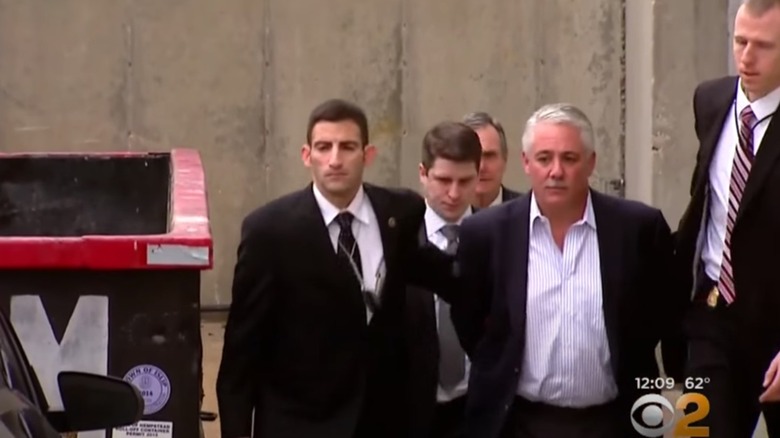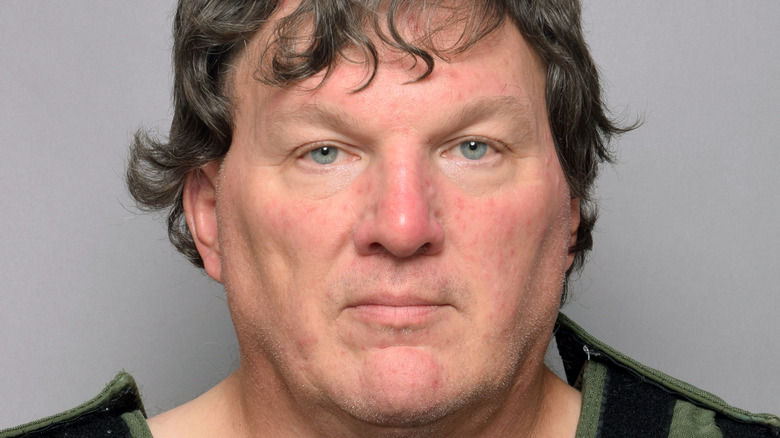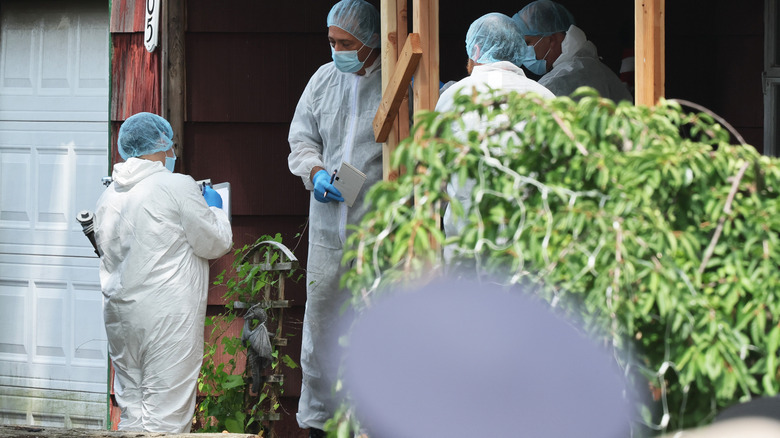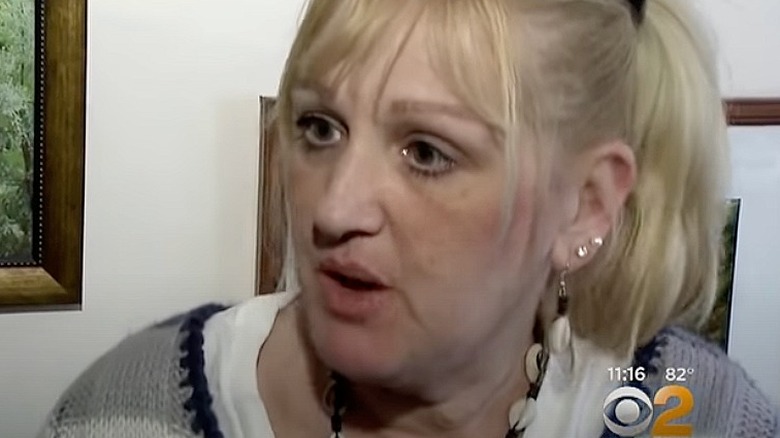The Untold Truth About The Gilgo Beach Murders
The story of the Gilgo Beach murders and the Long Island Serial Killer didn't really start with Shannan Gilbert's panicked 911 call in the early-morning hours of May 1, 2010, but that's when the whole thing began the more than decade-long process of unraveling for one of the country's most elusive serial killers. The 22-minute call was made public in 2022, and it's eerie listening (via NBC New York). Gilbert tells the dispatcher, over and over again: "There's somebody after me." Long silences are punctuated by screams, and after placing the call, she vanished.
In the process of searching for Gilbert, the remains of four women were discovered along a desolate, windswept stretch of Long Island beach. Police continued to find bodies: By the time they were done, they had recovered the remains of eight women, one man, and a toddler. Whispers of an active serial killer swept through the community, and then the case went cold.
Every so often, authorities would appeal for anything that might help bring a killer to justice, but it wasn't until 2023 that Rex Heuermann was arrested and charged with the murders of Melissa Barthelemy, Megan Waterman, and Amber Lynn Costello. Those who worked in the same Manhattan building as Heuermann were horrified by the realization that someone they'd shared an elevator with was accused in one of the area's most notorious murder cases, but it was a long road to get there — let's look at some of the stories that weren't covered in all the headlines.
Early work on the case was done by concerned sisters
Shannan Gilbert disappeared in May of 2010, and after a call from Shannan's boyfriend, her sisters, Sarra and Sherre, reported her missing. When law enforcement didn't act quickly enough, they headed down to Long Island to start looking for themselves.
Sherre told "48 Hours" (via CBS News) that they learned their sister — who was making ends meet as a sex worker advertising on Craigslist — had met a client for an appointment in a gated community in Long Island's Oak Beach (pictured). That's where she made the 911 call, and when Dominick Varrone, a former Suffolk County chief of detectives, started answering questions about that call, he was asked if Shannan's distracted, panicked voice was usual for someone fearing for their life. He responded, "You could make that argument. It almost seems like she's in some kind of psychotic state or in some kind of drug-induced stupor."
That's a pretty extreme leap to make, and it illustrates mother Mari Gilbert's point. For years, she was an outspoken advocate determined to earn respect for her daughter and the other victims, all identified as sex workers. She said (via The New York Times), "I think [authorities] look at them like they're throwaway. They don't care." Sherre Gilbert hasn't let up on those accusations, and in 2022, she called for the Suffolk Police Department to be held accountable in an independent investigation into their activities (via ABC News).
Half of the bodies were discovered by the same officer
After Shannan Gilbert disappeared, it took about a month before law enforcement assigned Suffolk County Police Department canine handler John Mallia to the case. He and his German shepherd, Blue, started looking near the gated community where Gilbert had last been seen. Having no luck, they gradually expanded their search efforts over the following months, until they started combing a strip of land along Ocean Parkway.
Once Blue got the scent they were searching for, things unfolded quickly... kind of. Mallia was on the scene to help homicide investigators collect evidence two days later when he found a second body, before Blue even got out of the car. By early afternoon, the pair had found two more. "It couldn't have been colder and windier," Mallia told The New York Times. "You didn't feel any of that. The adrenaline just took over. ... We came through some thick brush and we saw it together. It looked like a skull on top of a bag. Right away, we knew what it was."
Mallia and Blue would find five of the 10 bodies discovered along Gilgo Beach, and Mallia's perseverance was ultimately credited for kicking off the hunt for the Long Island Serial Killer. It's worth noting, too, that Mallia's determination extended to returning to the scene and spending his personal time searching for the missing Gilbert.
The Gilgo Beach murders go back much further than 2010
When Rex Heuermann was arrested and charged with three murders, authorities were quick to say that it wasn't an open-and-shut case. Criminologist Dr. Katherine Ramsland explained to PIX11, "There's a lot of differences in the way some of those victims were treated and then left, so I'm not sure [Heuermann's] attached to [all of] them."
That said, it's also worth noting that the activities of the killer — or killers — using Gilgo Beach as a dumping ground go back much further than 2010. Way back in 1996, a Suffolk County police officer discovered a pair of women's legs, wrapped in plastic and discarded in Fire Island's Davis Park. That officer told PIX11, "The nail polish from the pedicure was still fresh when I found them."
Fast forward to April of 2011 and the discovery of Gilgo Beach's ninth body. Those were partial remains, and DNA testing found them to belong to the same woman whose legs had been found 15 years earlier. DNA testing also revealed that she was the mother of the youngest of the Gilgo Beach victims, a toddler who was found not far from her. As of this writing in 2023, the woman and her toddler remain unidentified. There is still hope that they will be, however: It wasn't until 2020 that authorities announced they had identified Jane Doe No. 6 as Valerie Mack, thanks to a hit on a genealogy website.
The killer taunted the sister of one of his victims
After Rex Heuermann's arrest, he was charged with three murders, including the death of Melissa Barthelemy. She went missing in 2009, and not long after her disappearance, the Barthelemy family — particularly Melissa's teenage sister, Amanda — started getting some terrifying phone calls.
The calls always lasted less than three minutes and were made from Melissa's phone. On the other end was a male voice that mocked and taunted Amanda for holding on to the hope that she was ever going to see her sister again. According to The New York Times, mother Lynn Barthelemy had been told to keep the exact details of the conversations private in case they were ever needed for the investigation, but they did say that the caller ended the last phone call with a confession that he'd killed Melissa.
The calls themselves presented law enforcement with a bit of a puzzle. Former FBI agent Mary Ellen O'Toole told The New York Times that calling victims' families is a strange move: "You are putting yourself back into the investigation, when you should be running for the hills." On the other hand, it also made authorities suspect they were dealing with someone who knew law enforcement. The calls originated from crowded locations that made identifying him difficult, and by keeping the calls under three minutes, authorities couldn't trace him while he was on the line.
The focus fell on one suspect. What happened to him?
On the day Shannan Gilbert went missing after her frantic 911 call, she had been at the home of a man named Joseph Brewer. There are a few different versions of what happened that night, but it's generally accepted that she made the call from Brewer's house and fled, even though he had already called her driver to come pick her up and take her home.
Gilbert stopped and knocked on several doors in the neighborhood, leading to conflicting stories about who saw her and where she was headed. The most significant of those ended up being a conversation that happened years later, when one neighbor allegedly told another that a third local, Dr. Peter Hackett, had given Gilbert sedatives that night. The neighbor who supposedly started that story denied it, but it was enough to make Hackett a major suspect.
Gilbert's mother, Mari, also claimed that he had phoned her to tell her something strange: "I run a home for wayward girls." Hackett later denied that, but phone records show that he had actually called her, and when the calls to the Barthelemy family are considered, it looks weird. It was weird enough that Gilbert's family filed a wrongful death lawsuit against him, but it was eventually dismissed. Just what happened to Hackett is unclear, but Vice suggests that he moved to Fort Myers, Florida.
Accusations of police corruption and obstruction have been made
In 2023, The New York Times looked at why the case went cold, and traced part of the problem back to the area's police commissioner in 2012, James Burke. In spite of the fact that the FBI wanted to help with the case, Burke was accused of preventing federal involvement. Then, in 2016, a strange saga unfolded.
Burke was accused of punching a man who was being interrogated after reportedly stealing a duffel bag containing porn and sex toys out of Burke's car. (Burke was convicted in the incident.) Going back further, to 2013, PIX11 broke a story about Burke's early 1990s-era career and revealed that when he was a sergeant, he was romantically involved with a woman who was both a sex worker and a drug dealer. Burke had apparently turned a blind eye to criminal behavior that was happening in his jurisdiction. Incidents such as these have led Burke's colleagues — including Patrick Cuff, formerly of the Suffolk County Police — to say things like this about him: "To me, there is no better barometer of a person's integrity than to wind up at the top of Burke's enemy list."
There were a ton of tips and almost as many conspiracy theories
The most straightforward explanation for the remains discovered along Gilgo Beach is simple yet terrifying: The lonely stretch of waterfront scrubland is the dumping grounds for a serial killer. It's logical and awful at the same time, but not everyone believed that. According to some theories, the explanation is much more far-reaching.
According to Vice, one woman supposedly gave law enforcement her own 80-page theory about how a group of men who called themselves the Carney Construction Crew were responsible for the deaths. They, she claimed, were connected to a site called Utopia Guide. There, they discussed, rated, and ranked the sex workers they'd hired, sharing tips and recommendations among themselves until — she claims — they decided to go one step further.
That's not the only conspiracy theory that's been put forward, either. Some whisper claims that the killings happened after wild sex parties thrown by the rich got out of hand. Others think the girls were killed for snuff films, and there are even urban legend-style stories that claim other women have had the same final, fatal experiences as Shannan Gilbert. Timothy Sini had only recently become the county's police commissioner in 2016 when he told Vice, "We still get tips every day. Unfortunately, most of them seem to involve women who suspect their husband to be the killer." The truth is much more terrifying: Most spouses of serial killers have no idea what their partners are capable of.
It took a task force just six weeks to find a prime suspect
For years, the killings at Gilgo Beach have lingered as a dark cloud over the small communities of Long Island, and that started to change in December of 2021. That's when the NYPD's Rodney Harrison was tapped as the next police commissioner of Suffolk County, putting the case right on his desk. In February of 2022, he announced the establishment of a multi-agency task force, saying (via NBC New York), "As I said on Day One as police commissioner, I believe this case is solvable and identifying the person or people responsible for these murders is a top priority."
It was more than a year before news broke that Rex Heuermann had been arrested, but according to Suffolk County D.A. Ray Tierney's statement to CNN, Heuermann's name had come up as a prime suspect just six weeks after Harrison's task force got to work. There were a few red flags, including Heuermann's internet search history: It was filled with searches for the Gilgo Beach victims and their families.
Investigators concentrated on a few key pieces of evidence, including the location of the cell towers that the killer's burner phones pinged off of. That — along with a physical description — got them down to just a few people, and from there, it was actually a very old clue that provided the final link: A witness had placed Amber Lynn Costello with a man driving a green truck just like Heuermann's green Chevy Avalanche.
A 2011 profile was found to fit the suspect ultimately arrested
When The New York Times compared suspect Rex Heuermann to the predictions of a 2011 profile, they found startling similarities. The profile suggested they were looking for a well-educated, financially secure killer between 20- and 40-something years old, who lived in the area. Drew University assistant sociology professor Scott Bonn suggested, "This is someone who can walk into a room and seem like your average Joe. He has to be persuasive enough and rational enough that he is able to convince these women to meet him on these terms. He has demonstrated social skills. He may even be charming."
Heuermann was 59 at the time of his arrest, but he lived about 15 miles from Gilgo Beach and held a position at a Manhattan architectural firm. CNN referenced a video posted about a year before his arrest. In it, Heuermann describes his job as a sort of problem-solving architect, adding, "I think it's taught me more about how to understand people. ... it's the people, how they're all so different and how you deal with the people, I think, is one of the most interesting aspects [of the job]." As the profile suggested, he also owned an expensive vehicle: a Chevy Avalanche.
Investigators stress that it doesn't automatically mean guilt, but The Times got in touch with Bonn again. He said, "When I heard the news yesterday, I sort of had to smile to myself because it was pretty much what I had predicted."
The case is renewing awareness of sex trafficking and safety in sex work
After the news broke that a suspect had been arrested in connection with the Gilgo Beach murders, advocates working on behalf of sex trafficking victims and sex workers took the opportunity to remind the public that the case might be extreme, but violence against sex workers isn't unusual. CBS spoke with Alisa Bernard: A former sex worker, she's now a part of World Without Exploitation, an organization that fights human trafficking.
They asked her if she could recall a situation where she had been in fear for her life, and her response was eye-opening: "I think every single time I took a call, that was a thing that you think about," she said. She continued: "This guy is a perfect example. He may be the most extreme version, but what we hear day in and day out from survivors is that once the door closes and money is exchanged, that there's an extraordinary amount of violence."
Bernard also talked about what they were hoping to see develop, and that was basically laws to protect victims and prosecute those who harm them. It echoed the frustration of victims' families: The New York Times ran a piece condemning the way the victims of Gilgo Beach were long viewed. Melissa Cann, the sister of victim Maureen Brainard-Barnes, explained: "I don't like how they're talking about her. ... She was still a mother. She still meant the world to her daughter, she meant the world to me."
The fate of the Gilbert family is a reminder of the lasting impacts of tragedy
The Gilgo Beach murders were profiled in an in-depth book-turned-movie called "Lost Girls." Written by the journalist Robert Kolker, the book shares the stories not only of the victims, but of their families as well. Shannan Gilbert's mother, Mari (pictured), was a tireless advocate for all of the victims. Her story, though, continued to be a tragic one even after her daughter's remains were discovered in 2011.
What happened to Shannan's mother and sisters was documented by Kolker in an update to his book (via Esquire). He wrote that by 2013, Shannan's sister, Sarra, had begun to suffer from delusions and hallucinations, including the belief that artists like Beyoncé had become famous singing songs that she and Shannan had written. She also began to believe that she was a divine being who could see demonic presences possessing people, which all led to her being diagnosed with schizophrenia.
Her condition worsened. She was in and out of treatment facilities and killed her dog, then on July 23, 2016, she stabbed her mother 227 times. Kolker wrote (via The Sydney Morning Herald), "Mari's life, transformed by the death of one daughter, had been ended by another." Sarra was put on trial, and although her defense tried to argue insanity, prosecutors described the killing as a "crime of passion" partly driven by resentment over her mother's obsession with getting justice for her sister. Sarra was found guilty and given a 25-year prison sentence.
If you or someone you know needs help with mental health, please contact the Crisis Text Line by texting HOME to 741741, call the National Alliance on Mental Illness helpline at 1-800-950-NAMI (6264), or visit the National Institute of Mental Health website.











